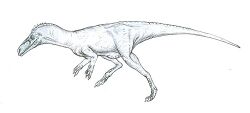Biology:Teyuwasu
| Teyuwasu | |
|---|---|

| |
| Life restoration | |
| Scientific classification | |
| Domain: | Eukaryota |
| Kingdom: | Animalia |
| Phylum: | Chordata |
| Clade: | Dinosauria (?) |
| Clade: | Saurischia (?) |
| Family: | †Herrerasauridae |
| Genus: | †Teyuwasu Kischlat, 1999 |
| Species: | †T. barbarenai
|
| Binomial name | |
| †Teyuwasu barbarenai Kischlat, 1999
| |
Teyuwasu is a dubious genus of dinosaur from the Late Triassic. Named by Edio-Ernst Kischlat in 1999, little is known about this genus; the type species, T. barbarenai, was named from leg bones (a femur and a tibia) discovered in paleorrota geopark, Brazil . The specific name honors Dr. Mário Costa Barberena, a South American paleontologist. Teyuwasu means "big lizard" in the Tupi language. The holotype, 1933L 53-54, is held at Ludwig Maximilians University of Munich.
The remains of Teyuwasu were originally attributed by Friedrich von Huene in 1938 to the aetosaur Hoplitosuchus.
A U-Pb (Uranium decay) dating found that the Santa Maria Formation dated around 233.23 million years ago, putting it 1.5 million years older than the Ischigualasto Formation, and making the two formations approximately equal as the earliest dinosaur localities.[1]
References
- ↑ Langer, M.C.; Ramezani, J.; Da Rosa, Á.A.S. (2018). "U-Pb age constraints on dinosaur rise from south Brazil". Gondwana Research X (18). doi:10.1016/j.gr.2018.01.005.
Kischlat, E.-E. (1999). "A new dinosaurian "rescued" from the Brazilian Triassic: Teyuwasu barbarenai, new taxon". Paleontologia em Destaque, Boletim Informativo da Sociedade Brasileira de Paleontologia 14(26) 58.
External links
Wikidata ☰ Q1031486 entry

